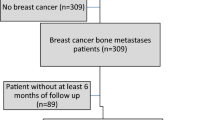Abstract
Background
Bone metastasis (BM) is important for studying systemic spread of breast cancer. It often causes skeletal-related events (SREs) that worsen quality of life. We investigated the prevalence and risk factors for BM and SRE using a dataset from the Breast Oncology Research Network (BORN) in Japan.
Patients and methods
We collected data on primary breast cancer patients with node-positive or node-negative disease at intermediate to high risk of recurrence. The risk factors affecting the BM-free rate, SRE-free rate and overall survival were analyzed by using the Cox proportional hazard model.
Results
Data of 1,779 patients who were diagnosed with breast cancer during 2003–2005 were collected from the BORN and 1,708 cases were used for analysis. The median follow-up duration was 5.71 years. BM developed in 193 cases (11.3 %) and the BM-free rate at 5 years was 89.2 %. The annual hazard ratio of BM development differs remarkably according to the tumor subtype. SREs occurred in 133 (68.9 %) out of 193 patients and the SRE-free rate at 5 years was 92.6 %. In the multivariate analysis, clinical stage (P < 0.0001), number of lymph node (LN) metastases (P = 0.0029), tumor subtype (P = 0.034) and progesterone receptor status (P = 0.038) were independently significant risk factors for BM-free rate, but only clinical stage (P < 0.0001) and number of LN metastases (P = 0.0004) significantly correlated with SRE-free rate.
Conclusions
This retrospective study clarifies the prevalence and risk factors for BM and SRE in Japanese breast cancer patients. Our results show the importance of considering subtype in the care of BM and SRE.



Similar content being viewed by others
References
Liang Y, Wu H, Lei R et al (2012) Transcriptional network analysis identifies BACH1 as a master regulator of breast cancer bone metastasis. J Biol Chem 287:33533–33544
Bidwell BN, Slaney CY, Withana NP et al (2012) Silencing of Irf7 pathways in breast cancer cells promotes bone metastasis through immune escape. Nat Med 18(8):1224–1231
Yao Y, Fang ZP, Chen H et al (2012) HGFK1 inhibits bone metastasis in breast cancer through the TAK1/p38 MAPK signaling pathway. Cancer Gene Ther 19:601–608
Gibert B, Eckel B, Gonin V et al (2012) Targeting heat shock protein 27 (HspB1) interferes with bone metastasis and tumour formation in vivo. Br J Cancer 107:63–70
Khatcheressian JL, Hurley P, Bantug E et al (2013) Breast cancer follow-up and management after primary treatment: American Society of Clinical Oncology Clinical Practice Guideline update. J Clin Oncol 31(7):961–965
Rosen LS, Gordon D, Tchekmedyian S et al (2003) Zoledronic acid versus placebo in the treatment of skeletal metastases in patients with lung cancer and other solid tumors: a phase III, double-blind, randomized trial—the Zoledronic Acid Lung Cancer and Other Solid Tumors Study Group. J Clin Oncol 21:3150–3157
Gnant M, Mlineritsch B, Schippinger W et al (2009) Endocrine therapy plus zoledronic acid in premenopausal breast cancer. N Engl J Med 360:679–691
Stopeck AT, Lipton A, Body JJ et al (2010) Denosumab compared with zoledronic acid for the treatment of bone metastases in patients with advanced breast cancer: a randomized, double-blind study. J Clin Oncol 28:5132–5139
Van Poznak CH, Temin S, Yee GC et al (2011) American Society of Clinical Oncology executive summary of the clinical practice guideline update on the role of bone-modifying agents in metastatic breast cancer. J Clin Oncol 29:1221–1227
Wong MH, Stockler MR, Pavlakis N (2012) Bisphosphonates and other bone agents for breast cancer. Cochrane Database Syst Rev 2:CD003474
Major PP, Cook RJ, Lipton A et al (2009) Natural history of malignant bone disease in breast cancer and the use of cumulative mean functions to measure skeletal morbidity. BMC Cancer 9:272
Metzger-Filho O, Sun Z, Viale G et al (2013) Patterns of recurrence and outcome according to breast cancer subtypes in lymph node-negative disease: results from International Breast Cancer Study Group Trials VIII and IX. J Clin Oncol 31(25): 3083–90.
Kennecke H, Yerushalmi R, Woods R et al (2010) Metastatic behavior of breast cancer subtypes. J Clin Oncol 28:3271–3277
Parker JS, Mullins M, Cheang MC et al (2009) Supervised risk predictor of breast cancer based on intrinsic subtypes. J Clin Oncol 27:1160–1167
Dent R, Trudeau M, Pritchard KI et al (2007) Triple-negative breast cancer: clinical features and patterns of recurrence. Clin Cancer Res 13:4429–4434
Kiba T, Inamoto T, Nishimura T et al (2008) The reversal of recurrence hazard rate between ER positive and negative breast cancer patients with axillary lymph node dissection (pathological stage I–III) 3 years after surgery. BMC Cancer 8:323
Alanko A, Heinonen E, Scheinin T et al (1985) Significance of estrogen and progesterone receptors, disease-free interval, and site of first metastasis on survival of breast cancer patients. Cancer 56:1696–1700
Hess KR, Pusztai L, Buzdar AU et al (2003) Estrogen receptors and distinct patterns of breast cancer relapse. Breast Cancer Res Treat 78:105–118
Acknowledgments
We are grateful to all of the co-investigators for their cooperation in this BORN1 study. The authors also thank the following additional investigators for their contributions to this study: Hideaki Kaneda, Koichi Yamashiro, Yoko Kudo in data management; Hiroyuki Ueshima and Miyuki Kawabata as the project office staff; and Masanori Fukushima, M.D., Ph.D., as a director of FBRI-TRI.
Conflict of interest
The authors declare that they have no conflict of interest.
Author information
Authors and Affiliations
Corresponding author
About this article
Cite this article
Yamashiro, H., Takada, M., Nakatani, E. et al. Prevalence and risk factors of bone metastasis and skeletal related events in patients with primary breast cancer in Japan. Int J Clin Oncol 19, 852–862 (2014). https://doi.org/10.1007/s10147-013-0643-5
Received:
Accepted:
Published:
Issue Date:
DOI: https://doi.org/10.1007/s10147-013-0643-5




